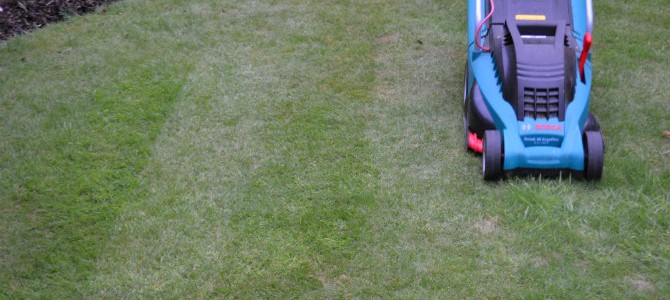How to mow a lawn
by Drucilla James

Whether you have a postage stamp or a large expanse, the lawn is an integral part of the picture you are trying to create in your garden. A well-kept lawn enhances the impact of plants quite dramatically. A simple care regime will help make this a reality.
Mowing obviously takes away the grass’s leaves and therefore depletes the nutrients available, so feeding the lawn has to be organised alongside the mowing. Check up on the appropriate spring, summer and autumn fertiliser.
Mowing a lawn to the correct height at the right time of year is crucial to achieve a green, healthy, thick and strong lawn.The most frequent error made when mowing is to cut the grass too low; this causes the surface to dry out and allows moss to get a foothold. It is also not advisable, because leaves grow from the base of the plant not from the shoot tips. However if grass is mown too high, this can result in weak, long stems and leaves which create a thin sward. Cutting at the right height stimulates side shoots to grow and a strong root system, which in turn thickens the grass, fills any areas of bare soil and thus reduces invasion by weeds and moss. Frequency is important too as leaving grass to get too long and then giving it a savage cut, leaves an unsightly lawn that then takes time to get back to the attractive area you are trying to achieve.
Timing:
Spring: For the first cut of the year, pick a dry day when the grass is dry. Set the mower blade(s) to about 3 cm. Mow once a week.
Summer: Frequent mowing at this time of the year is no great chore if you follow a well-planned regime. Mow certainly once a week but more likely twice a week. Do not skimp on this. Set the mower to 2 cm. High quality bowling- green -type lawns can be cut to 1 cm, but most people do not aspire to these, especially those with families. During very dry periods, you will need to water the lawn in the early morning or late evening or if you have the time, both.
Autumn: Mow once a week. Scarifying and aerating ( see http://www.cityplanter.co.uk/practical/how-to/how-to-look-after-your-lawn-in-autumn) are important jobs to be included in your regime for this part of the year.
Winter: The lawn can be mown in the winter if the grass has grown too long or to remove fallen leaves. Only do this during mild, dry periods and set the mower blade at a high level.
What you will need:
- Mower: Types available are: 1. Hover. 2. Rotary. 3. Cylinder- the hand- driven version is the most environmentally friendly.
- Edging shears (L shaped shears)
- Half moon edger or sharp spade
How to do it:
1) Check the lawn for bits of gravel, stones or twigs as these can be a danger if thrown out by the mower and also damage the mower blades.
2) Plan the starting point and direction you are going to begin the mowing- are there any difficult little areas and how will you deal with those? The shape of lawn we have has often been determined by other changes such as new beds or what we have inherited from someone else. Not many of us have a large rectangular lawn, but whatever the shape, visualise it as a rectangle and cut it accordingly. Deal with the small awkward remaining shapes at the end. If your mower can leave stripes think what these will look like when you have finished. Mowers with a rear roller leave better stripes but many rotary mowers can now create an acceptable stripe effect.
3) Do not move the mower around as you would if you were vacuuming a carpet, move the mower forward only and you will achieve a more consistent cut.
4) Each time you mow, cut the grass at ninety degrees to the previous direction of cut as this will help create a more regular mowing to the lawn.
5) An example: a simple rectangular lawn
Cut along the short edge of the rectangle, turn and come back along, parallel and up to that line. Turn the mower when you get back to the edge you started from and go down the long edge to the end. At the end, turn along the other short side and come back parallel as before. When you reach the long edge turn back down that keeping alongside the first cut but in the opposite direction. At the end of that long side turn again, and keep repeating the process until the whole lawn has been cut. As you mow, you will be forming parallel rows.At the end you will get back to the short side from where you started.
6) Tidy up the edges keeping them crisp and neat using edging shears.
7) To make edging easier and stop the grass growing into flower beds,once or twice a year, use a half moon edger or sharp spade to cut a 10 cm deep channel at the edge of the lawn sloping it up into the flower bed. Check regularly and keep the channel clear.
To summarise:
(1) Establish a manageable regime for the year and be prepared to adjust it depending on weather conditions.
(2) Get the cutting height correct at each time of the year.
(3) Feed the lawn with the correct fertiliser through the year.

